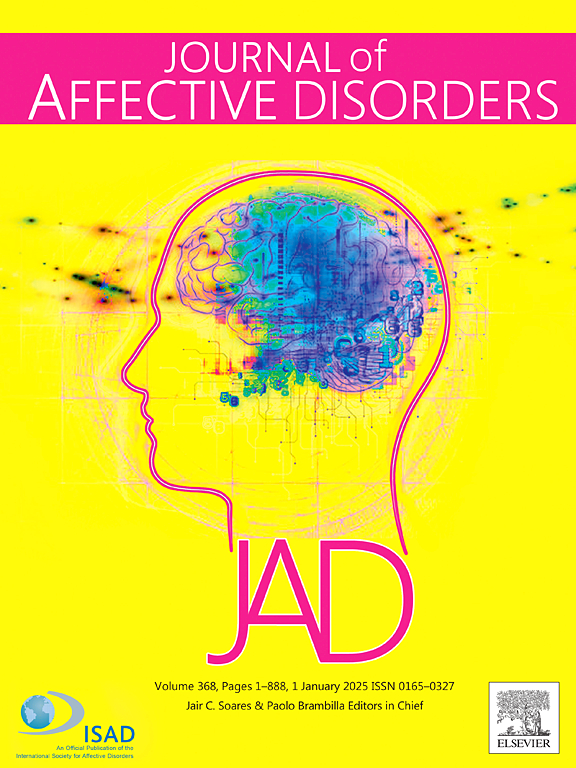Diagnostic and clinical characteristics in psychiatric outpatients with suicidality in the context of irritability
IF 4.9
2区 医学
Q1 CLINICAL NEUROLOGY
引用次数: 0
Abstract
Background
This study examines differences in psychiatric diagnoses and clinical symptoms between patients with suicidality with and without irritability, while also exploring the moderating role of sex on these distinctions.
Methods
Medical records of 6118 psychiatric outpatients in South Korea, including structured clinical interviews and standardized rating scales, were retrospectively reviewed. Patients were categorized into four groups based on the presence or absence of suicidality and irritability: suicidality with irritability (SI group; n = 345), suicidality only (S group; n = 1918), irritability only (I group; n = 283), and neither (N group; n = 3572).
Results
Bipolar, substance use, eating, and personality disorders were most prevalent in SI group, whereas depressive disorders were most frequent in S group. Psychotic and neurocognitive disorders predominated in I group, while anxiety, somatic symptom, sleep, and trauma- or stressor-related disorders were most common in N group. SI and S groups exhibited higher depression, anxiety, hopelessness, attention deficits, and alcohol use compared to I and N groups. S group demonstrated greater hopelessness than SI group. SI group showed lower prevalence of depressive disorders and higher bipolarity than S group, with these differences more pronounced in males than females. Somatic symptom disorders in SI group were more frequent in males but less common in females compared to S group.
Conclusion
This study highlights diagnostic and symptomatic distinctions among psychiatric outpatients with suicidality, depending on the presence of irritability, and underscores the moderating role of sex. The combination of suicidality and irritability appears to represent a qualitatively distinct clinical manifestation compared to suicidality alone.
精神科门诊患者因易怒而产生自杀倾向的诊断和临床特征
背景:本研究探讨了有和无烦躁性自杀患者在精神病学诊断和临床症状上的差异,同时也探讨了性别在这些差异中的调节作用。方法回顾性分析韩国6118例精神科门诊患者的病历,包括结构化临床访谈和标准化评定量表。根据患者是否有自杀倾向和激惹性分为四组:有自杀倾向并有激惹性(SI组;n = 345),仅自杀倾向(S组;n = 1918),仅易激惹性(I组;n = 283),均不存在(n组;n = 3572)。结果双相情感障碍、物质使用、饮食障碍和人格障碍在SI组中最常见,而抑郁症在S组中最常见。I组以精神病和神经认知障碍为主,而N组以焦虑、躯体症状、睡眠和创伤或压力相关障碍最为常见。与I和N组相比,SI组和S组表现出更高的抑郁、焦虑、绝望、注意力缺陷和酒精使用。S组比SI组表现出更大的绝望感。SI组抑郁症患病率较S组低,双相情绪较S组高,且男性比女性差异更明显。与S组相比,SI组男性躯体症状障碍发生率较高,而女性较低。结论本研究强调了精神科门诊患者自杀倾向的诊断和症状差异,这取决于易怒的存在,并强调了性别的调节作用。与单独的自杀倾向相比,自杀倾向和易怒倾向的结合似乎代表了一种质量上不同的临床表现。
本文章由计算机程序翻译,如有差异,请以英文原文为准。
求助全文
约1分钟内获得全文
求助全文
来源期刊

Journal of affective disorders
医学-精神病学
CiteScore
10.90
自引率
6.10%
发文量
1319
审稿时长
9.3 weeks
期刊介绍:
The Journal of Affective Disorders publishes papers concerned with affective disorders in the widest sense: depression, mania, mood spectrum, emotions and personality, anxiety and stress. It is interdisciplinary and aims to bring together different approaches for a diverse readership. Top quality papers will be accepted dealing with any aspect of affective disorders, including neuroimaging, cognitive neurosciences, genetics, molecular biology, experimental and clinical neurosciences, pharmacology, neuroimmunoendocrinology, intervention and treatment trials.
 求助内容:
求助内容: 应助结果提醒方式:
应助结果提醒方式:


